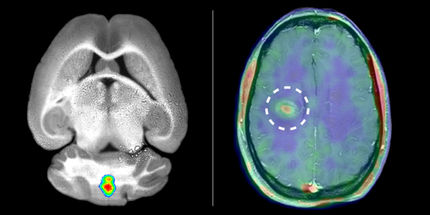Carnegie Mellon MRI technology that non-invasively locates, quantifies specific cells in the body
magnetic resonance imaging (MRI) isn't just for capturing detailed images of the body's anatomy. Thanks to novel imaging reagents and technology developed by Carnegie Mellon University scientist Eric Ahrens, MRI can be used to visualize cell populations of interest in the living body. The ability to non-invasively locate and track cells, such as immune cells, will greatly aid the study and treatment of cancer, inflammation, and autoimmune diseases, as well as provide a tool for advancing clinical translation of the emerging field of cellular regenerative medicine, by tracking stem cells for example.
"With our technology we can image specific cells in real-time with exquisite selectivity, which allows us to track their location and movement and to count the apparent number of cells present. We then use conventional MRI to obtain a high-resolution image that places the labeled cells in their anatomical context," said Ahrens, an associate professor of biological sciences at the Mellon College of Science.
The ability to track the movement and eventual location of specific immune cells is critical for understanding the cells' role in disease and therapeutic mechanisms, and for developing effective cell-based therapeutics. Other MRI methods for visualizing cells use metal-based contrast agents, which can make it difficult to clearly identify labeled cells in the body, according to Ahrens.
"The large background signal from mobile water and intrinsic tissue contrast differences can often make it challenging to unambiguously identify regions containing these metal-ion labeled cells throughout the body, which is the current state of the art," Ahrens said.
Ahrens's new approach — fluorocarbon labeling — solves this problem by producing images that clearly show the labeled cells at their precise location in the body. Ahrens first labels the cells of interest with a perfluoropolyether (PFPE) nanoemulsion, which is a colloidal suspension of tiny fluorocarbon droplets. Then, he introduces the labeled cells into an animal subject and tracks the cells in vivo using 19F MRI.
While conventional MRI detects the nuclear magnetic resonance signal from protons contained in the mobile water in tissue, 19F MRI detects the signal from the nucleus of the fluorine atom. Fluorine is not normally present in the body at sufficient concentrations to detect, so when Ahrens labels cells with PFPE, he can detect this fluorine 'tracer' with MRI after the cells are transplanted into the body. The Ahrens' team has recently used the PFPE technology to label and track dendritic cells and T cells in a mouse model of type I diabetes, a disease in which immune cells infiltrate the pancreas, attacking and damaging the body's own cells.
Most read news
Topics
Organizations

Get the analytics and lab tech industry in your inbox
By submitting this form you agree that LUMITOS AG will send you the newsletter(s) selected above by email. Your data will not be passed on to third parties. Your data will be stored and processed in accordance with our data protection regulations. LUMITOS may contact you by email for the purpose of advertising or market and opinion surveys. You can revoke your consent at any time without giving reasons to LUMITOS AG, Ernst-Augustin-Str. 2, 12489 Berlin, Germany or by e-mail at revoke@lumitos.com with effect for the future. In addition, each email contains a link to unsubscribe from the corresponding newsletter.


























































